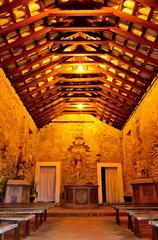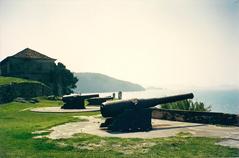Forte da Ponta das Almas: Visiting Hours, Tickets, and Historical Significance in Florianópolis
Date: 04/07/2025
Introduction
Nestled on Ilha de Santa Catarina in Florianópolis, Brazil, Forte da Ponta das Almas is a historically rich site that encapsulates the city’s layered past—from ancient indigenous settlements to a pivotal role in colonial defense strategy. Although less prominent than nearby fortresses like Fortaleza de Santa Cruz de Anhatomirim or Fortaleza São José da Ponta Grossa, Ponta das Almas offers a unique blend of archaeological intrigue and panoramic natural beauty. Visitors can experience echoes of 18th-century military engineering while walking amidst shell mounds (sambaquis) dating back over 4,200 years, linking the site to both indigenous heritage and European colonization (Guia Floripa; ND Mais).
This comprehensive guide covers everything you need to know about visiting Forte da Ponta das Almas: hours, accessibility, travel tips, history, nearby attractions, and the site’s ongoing preservation. Whether you are a history buff, nature lover, or cultural explorer, read on to plan a meaningful visit to one of Florianópolis’s most fascinating historical landmarks.
Contents
- Introduction
- Historical Overview
- Colonial Context and Strategic Importance
- Construction and Architectural Features
- Role in Defense and Historical Events
- Decline and Preservation
- Archaeological and Cultural Significance
- Visiting Forte da Ponta das Almas: Hours, Tickets, and Accessibility
- Visitor Experience and Guided Tours
- Conservation and Community Stewardship
- Nearby Attractions
- Practical Tips
- Frequently Asked Questions (FAQ)
- Conclusion & Further Resources
Historical Overview
Colonial Context and Strategic Importance
Forte da Ponta das Almas was constructed in the mid-18th century as part of the Portuguese colonial defense network. The southern coast of Brazil, especially the Ilha de Santa Catarina, was a strategic frontier between Portuguese and Spanish domains. To safeguard maritime routes and the settlement of Vila de Nossa Senhora do Desterro (now Florianópolis), the Portuguese established a series of fortifications. The Treaty of Madrid (1750) heightened the urgency for these defenses, and while Ponta das Almas was smaller and less documented than major forts, it played an important supporting role in securing access to the northern bay of the island (Guia Floripa).
Construction and Architectural Features
Forte da Ponta das Almas was built using local stone and lime mortar, typical of colonial military engineering. Its design featured thick walls, artillery bastions, and a strategic location providing surveillance over Lagoa da Conceição and the Atlantic coast. Although much of the structure is now in ruins, archaeological research has identified remnants of walls, bastions, and potential artillery placements (ND Mais).
Role in Regional Defense and Historical Events
The fort was part of a comprehensive defensive system alongside Fortaleza de Santa Cruz de Anhatomirim, Fortaleza São José da Ponta Grossa, and others. These forts protected against Spanish naval threats and helped maintain Portuguese control during colonial skirmishes and the early years of Brazilian independence (Aliki Travel Blog). No major battles are recorded at Ponta das Almas, but its presence contributed to regional stability.
Decline and Preservation
As the colonial era waned and military threats diminished, the fort lost strategic importance and fell into disuse by the late 19th century. Many original features were lost to abandonment, environmental factors, and lime extraction from sambaquis for building materials. Restoration and research efforts in recent decades, led by the Universidade Federal de Santa Catarina (UFSC) and protected by federal law, have stabilized the site and promoted its cultural value (ND Mais).
Archaeological and Cultural Significance
Forte da Ponta das Almas sits atop some of southern Brazil’s most significant sambaquis—ancient shell mounds built by indigenous societies over 4,200 years ago (ND Mais). Excavations have uncovered evidence of sustained indigenous occupation, including food remains, charcoal, hearths, and burial sites. The fort’s construction atop these ancient mounds exemplifies the complex intersection of pre-colonial and colonial histories in Florianópolis.
Beyond archaeology, the site holds deep cultural resonance for local “manezinhos” communities. Oral histories, religious traditions, and community events often reference the area, weaving together indigenous and colonial narratives (Facts.net).
Visiting Forte da Ponta das Almas: Hours, Tickets, and Accessibility
- Visiting Hours: Open year-round during daylight (generally sunrise to sunset). No official closing time, but visits after dark are not recommended.
- Tickets: Entry is free for all visitors.
- Access: Reachable only on foot via trails from Lagoa da Conceição; there is no direct vehicle access.
- Accessibility: The site’s uneven terrain and partial ruins present challenges for those with mobility limitations. Wear sturdy footwear and plan for basic conditions.
- Facilities: No restrooms, shops, or services on-site. Bring water, snacks, and sun protection (Wikiloc).
- Guided Tours: Arrange in advance through UFSC or local cultural organizations for deeper historical and archaeological context.
Visitor Experience and Guided Tours
Exploring Forte da Ponta das Almas offers serene views of Lagoa da Conceição, lush Atlantic Forest, and glimpses of Florianópolis’s historic landscape. Interpretive signage is limited, but some educational panels and digital resources help visitors understand the site’s significance. Guided tours provide valuable insights into both the archaeological layers and colonial history.
The area occasionally hosts cultural events, art installations, and traditional markets, particularly during peak tourist seasons (Facts.net). Photographers will enjoy sunrise or late afternoon light for capturing the lagoon, forest, and cityscape.
Conservation and Community Stewardship
Forte da Ponta das Almas is protected as a National Historic Heritage site (Law 3924/61) and managed collaboratively by UFSC, the Instituto do Patrimônio Histórico e Artístico Nacional (IPHAN), and the local community. The site features in Florianópolis’s 2023–2033 Strategic Tourism Plan, with priorities including improved signage, upgraded trails, and digital enhancements for visitors (ND Mais). Community engagement and educational outreach ensure ongoing stewardship and respect for cultural heritage.
Nearby Attractions
While visiting Forte da Ponta das Almas, consider exploring these nearby sites:
- Fortaleza de Santa Cruz de Anhatomirim: Accessible by boat, this well-preserved fortress offers guided tours and panoramic views.
- Fortaleza São José da Ponta Grossa: Located to the north, this fort provides exhibits on military history and beautiful beaches (Visite Floripa).
- Historic Center of Florianópolis: Explore colonial architecture, markets, and museums for a deeper dive into the island’s history.
- Waterfront Parks & Beaches: Enjoy recreational trails, city views, and local cafés.
Practical Tips
- Best Time to Visit: Spring and fall (September–November, March–May) offer mild weather and fewer crowds.
- What to Bring: Water, snacks, sun protection, sturdy shoes, and a camera.
- Safety: Trails may be slippery after rain; exercise caution and respect environmental guidelines.
- Respect: Do not remove artifacts or disturb archaeological features. Carry out your trash.
- Community: Be mindful of local residents and their privacy, especially in residential neighborhoods.
Frequently Asked Questions (FAQ)
Q: What are the visiting hours for Forte da Ponta das Almas?
A: Open year-round during daylight hours (sunrise to sunset).
Q: Is there an entrance fee?
A: No, visiting the site is free.
Q: How do I get there?
A: Access is by foot via trails starting from Lagoa da Conceição. There is no direct vehicle access.
Q: Are guided tours available?
A: Yes, by appointment through UFSC or local cultural organizations.
Q: Is the site accessible for people with disabilities?
A: Accessibility is limited due to uneven, natural terrain.
Q: What nearby attractions can I combine with my visit?
A: Fortaleza de Santa Cruz de Anhatomirim, Fortaleza São José da Ponta Grossa, and the historic center of Florianópolis.
Conclusion
Forte da Ponta das Almas is a living testament to the intertwined stories of indigenous resilience and colonial ambition on the southern Brazilian coast. While the fort itself is modest and partially in ruins, its archaeological significance, scenic setting, and community connections make it a compelling stop for anyone interested in Florianópolis’s heritage. Free and accessible, the site rewards prepared visitors with history, nature, and cultural discovery.
To enrich your experience, consider combining your visit with other historical and natural attractions in Florianópolis. For updates on guided tours, special events, and conservation efforts, download the Audiala app, consult local tourism authorities, and follow us on social media.
Recommended Visuals and Media
- High-resolution photos of Lagoa da Conceição, sambaqui remains, and panoramic views (e.g.,
 )
) - Interactive map showing the fort’s location and surrounding attractions
- Short video or virtual tour for remote visitors
Related Articles
Key Sources
For more guides, tips, and historical explorations in Florianópolis, follow Audiala’s latest articles and updates.






